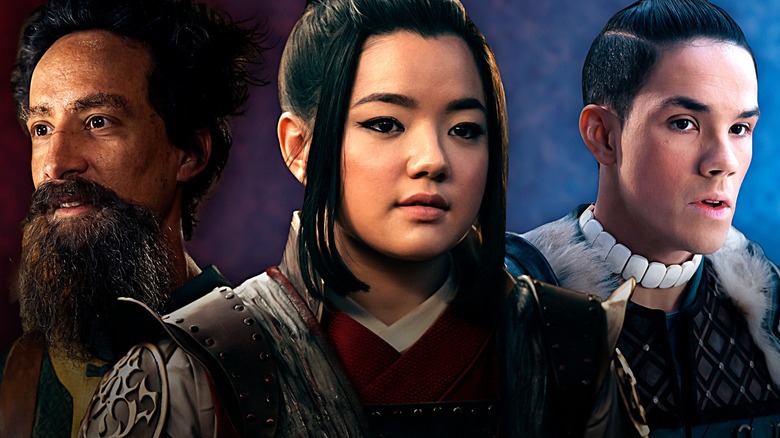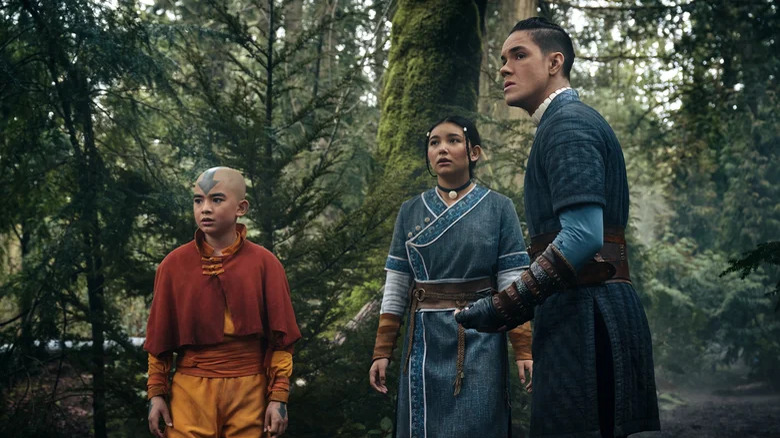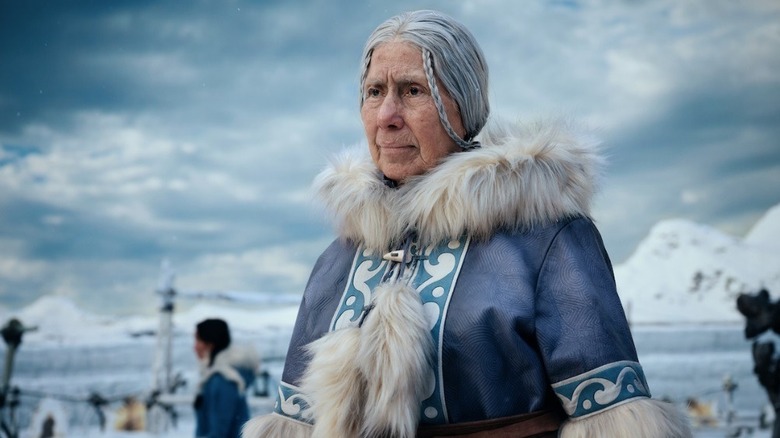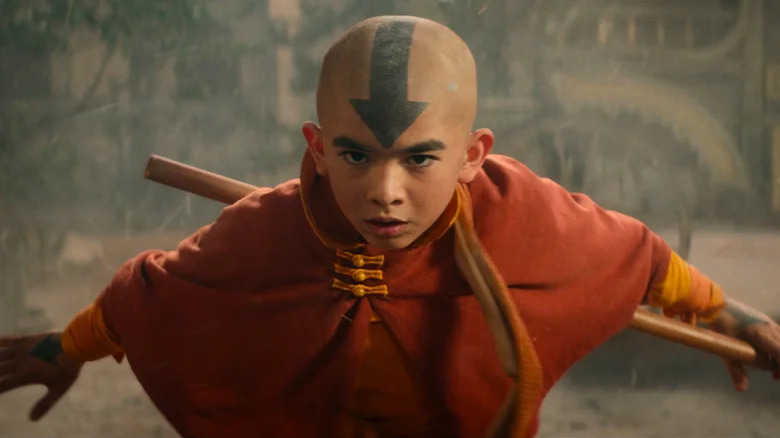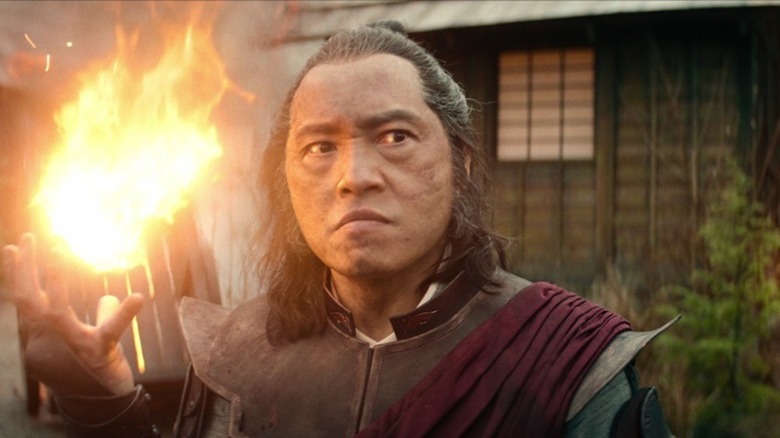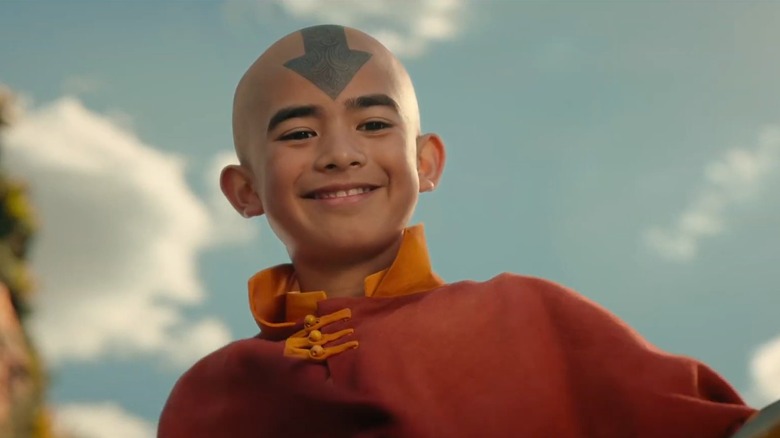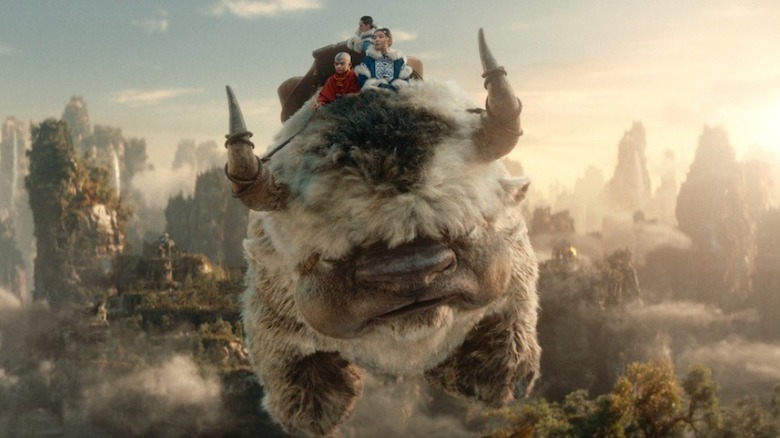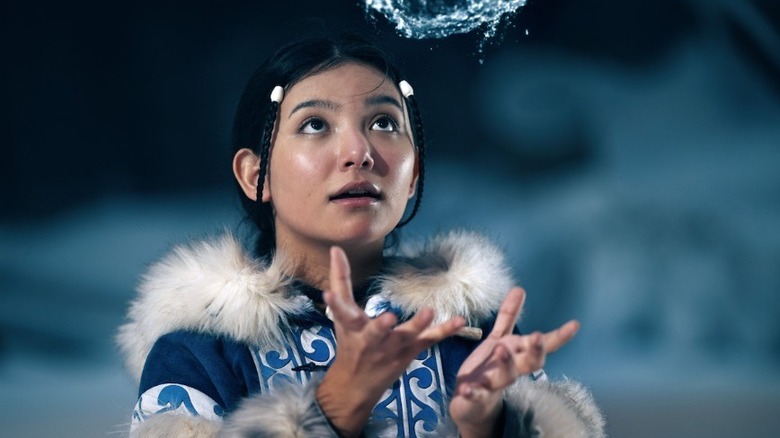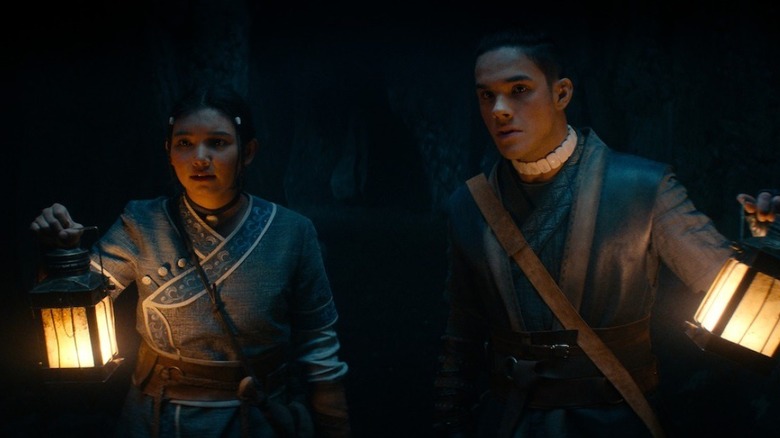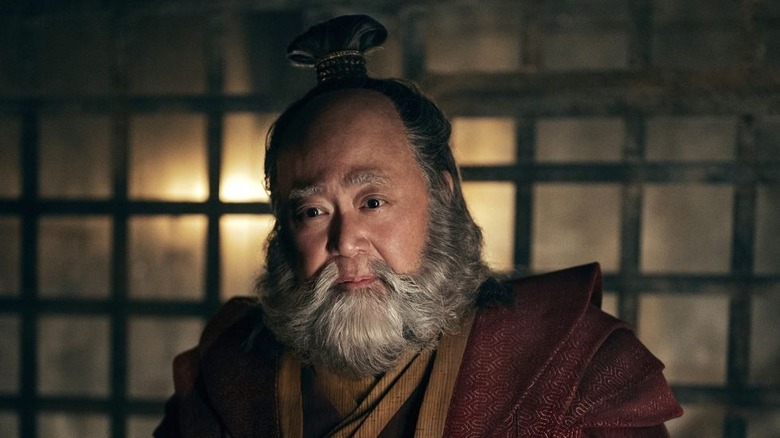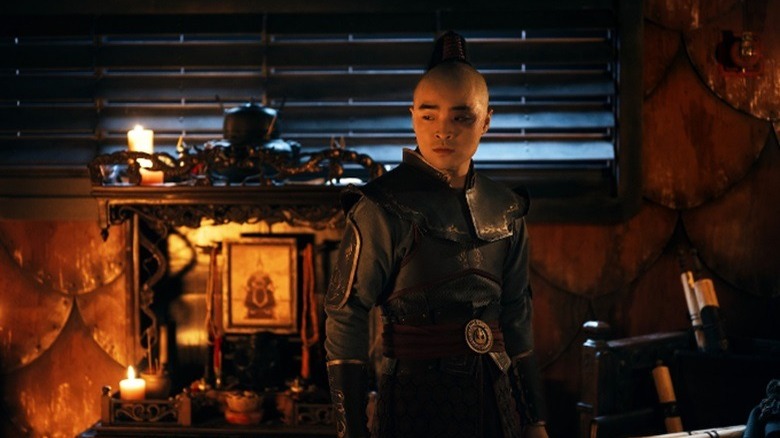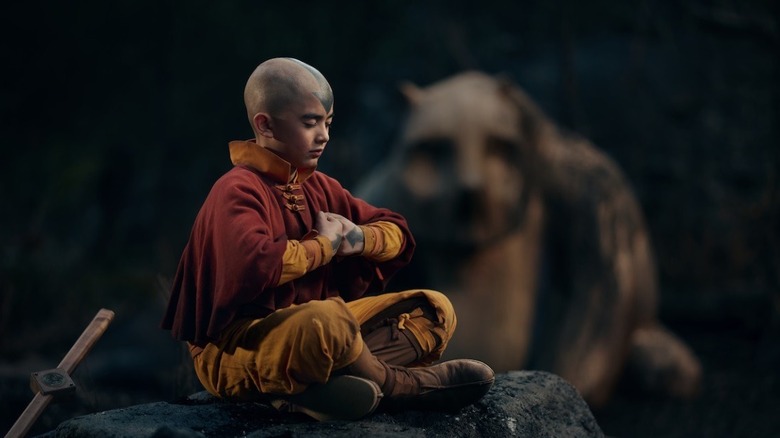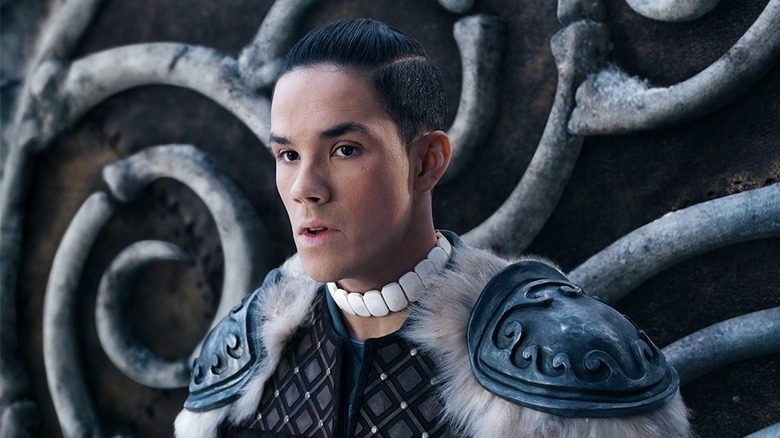Netflix's Live-Action Avatar: The Last Airbender Changes That Upset Fans The Most
"Avatar: The Last Airbender" remains one of the most beloved and critically acclaimed animated series of all time. When a live-action show was announced, fans expressed their apprehension — for good reasons, too. For one, the rotten sock smell of M. Night Shyamalan's 2010 film still lingered in the air. And two, live-action adaptations of popular cartoons don't have a good track record overall, bar exceptions such as "One Piece." Matters weren't helped much when news broke that the original creators, Michael Dante DiMartino and Bryan Konietzko, tapped out as showrunners after creative differences with Netflix. So how bad was this going to be on a scale of one to "Cowboy Bebop"?
Despite those fears, the live-action "Avatar: The Last Airbender" has proved to be far from the disaster many had anticipated. Sure, it doesn't reach the gold standard set by the animated series, but it's a drastic improvement over the awful 2010 movie. Overall, most fans appear to be satisfied with how the first season of the show turned out. That said, there are still a few gripes and niggles that they can't look past. Some of these complaints might be related to personal choices or preferences; however, these changes still disappointed a number of long-time "Avatar" viewers in the end.
The pacing of the story leaves a lot to be desired
The story of "Avatar: The Last Airbender" is divided into three books or seasons. In the animated series, the events of Book One, titled "Water," are told over 20 episodes. The first season of the live-action show chooses to do this in eight. Even though the latter's episodes are longer in length, often nearing the one-hour mark, there's a lot of material that's skipped over or only briefly mentioned here. For some fans, they found this choice to impact the pacing of the series, especially the first episode, as it moves at a breakneck speed to cover a lot of ground.
Redditor u/Kawakiki couldn't help but comment about it by the third episode, stating: "The pacing feels so off. I get they wanna cram in as much elements from Season 1 but the way things are stitched together came off really odd [in my opinion] ... Maybe it's more beneficial for first-time viewers." Another user agreed with u/Kawakiki in the sense that this was likely done for the benefit of new viewers.
Unquestionably, the animated series allowed its characters space to breathe and showcased more lighthearted and playful moments between the likes of Aang, Katara, and Sokka as they got to know each other over time. Since the live-action show doesn't have the luxury of episodes to spare, it glosses over these scenes or excludes them entirely as it races to the next major beat in the story.
Avatar: The Last Airbender decides to tell rather than show
By cutting down or condensing events from the animated series, Netflix's live-action "Avatar: The Last Airbender" show has had to figure out another way of conveying important information from these scenes that could still be pivotal to the greater storyline. Instead of weaving it into the action in an organic and fluid manner, a high degree of exposition dumps take place where the characters reveal everything in stilted and overstuffed conversations. It's something that a lot of fans have noticed, remarking about how unnatural and forced it feels.
@ChrisJHerman took to X (formerly known as Twitter) to blast the writing and overuse of exposition between characters. "I was digging 'Avatar: The Last Airbender' for a bit until people started having conversations," the user wrote. "Wow, this dialogue is stiff and exposition heavy. Sokka and Katara's exchanges feel like they're written by ChatGPT." Ouch.
Aang's introduction wasn't a home run
The opening of Netflix's "Avatar: The Last Airbender" deviates from the original series' introduction, as it shows the events before Aang (Gordon Cormier) finds himself stuck in an iceberg for 100 years. While many fans have praised the dazzling action-packed sequence that sees Fire Lord Sozin (Hiro Kanagawa) lay siege on the Air Nomads at the Southern Air Temple, there are others who feel this scene had a major negative impact on another vital aspect of the story.
In the original show, Aang doesn't know all of his people are dead until he goes back to the temple. He hangs onto a glimmer of hope that there will still be others until he finds out otherwise. In the live-action show, he knows everyone is dead before he goes to the temple.
Several Redditors expressed their disappointment at this change, with u/sha_13 writing: "I absolutely despise the change that Aang finds out before he gets to the temple. What an underwhelming reaction to finding out everyone died. I love how in the [original series] he was in denial until he saw Gyatso's corpse. I don't mind changes but not when they don't make sense."
Zhao and Zuko have a different relationship
In the original series, the tension between Zhao and Zuko doesn't simmer — it burns like ankles over hot coals. These two Firebenders do not like each other one bit. While Netflix's live-action "Avatar: The Last Airbender" doesn't shy away from showing that they are far away from spending an evening roasting marshmallows together, changes have been made to their dynamic and the relationship feels more passive-aggressive than noticeably hostile. The pair come across as two co-workers who might throw thinly veiled barbs via email rather than engage in an all-out melee to resolve their issues. Fans also noticed a shift in this rivalry, especially in how Zhao (Ken Leung) comes across more calmly and cunning rather than fiery and impulsive.
@NinaEliks couldn't understand the reasoning behind the change to Zhao and Zuko's (Dallas Liu) relationship, writing on X: "Dumbing down Zhao and making him less important is a weird choice. His rivalry with Zuko was one of the most interesting plots of the first season." Despite criticism for this change from some quarters, there were others who admitted to liking it and the unpredictable element it brings to the show.
Aang can fly without his glider
One of the most glaring changes that eagle-eyed "Avatar: The Last Airbender" fans noticed in the first episode of the Netflix show was Aang having the ability to fly without the glider, as he swoops down from the top of the building toward Gyatso (Lim Kay Siu), who waits for him on the ground. Those who are knee-deep in the lore were outraged since Aang shouldn't be able to do this, according to the source material. He does, of course, use his glider later on in the show.
X user @yamilVII was having none of it, writing: "I'm 7 minutes into the first [episode] of #AvatarTheLastAirbender live action and it's already clear they don't understand the characters. Like why the f*** can Aang fly without a glider? If they watched ['The Legend of Korra'], they would've known this isn't possible, also Aang never flew without his glider."
Other fans disputed this, suggesting that Aang wasn't flying but using his own body to glide for a short period of time. Since he's an Airbender, this should be something he can do in bursts, especially if he's descending somewhere. Nonetheless, this still remains a hot debate that has the fandom up in arms.
More Momo and Appa is needed
Everyone loves cute animals and cuddly creatures. In fact, it's almost an unspoken rule that cartoons need to focus on at least one of them per episode. The original "Avatar: The Last Airbender" animated series features two adorable fluffs in the form of the flying bison Appa and the big-eared lemur Momo. While both make appearances in the live-action show, it wasn't nearly enough for fans who wanted more of them — and rightfully so.
X user @ammsspoath expressed their disappointment at the lack of the creatures, stating: "Momo and Appa are rarely seen. I get why — their CGI probably costs a lot. But it's sad that we don't get to see them that often."
Of course, the user is likely spot-on about the main reason they don't appear as often as fans might have wanted. Both creatures require heavy amounts of CGI to bring them to life and considering how dependent "Avatar" is on special effects for all aspects of the show, the Netflix executives would likely turn into angry Firebenders if the budget increased. Sadly, Appa and Momo had to take a backseat for the greater good here.
Katara isn't quite the same character she was in the cartoon
Out of the main cast, it's Kiawentiio's Katara who has come under fire the most from viewers. One of the biggest gripes is how this version of the popular character doesn't show the same level of feistiness and bravado as Mae Whitman's Katara from the original series. Instead, fans wanted Kiawentiio to play Katara more like Whitman did.
Characterization problems aside, there were also complaints about Kiawentiio's acting ability from various commentators, with @SosoTheWanderer posting the following on X: "Yeah ... Katara's acting is wooden. Please get her a coach because I do like her look. But she can't show emotion to save her life."
While everyone is entitled to their own opinion, it might be a little premature to lay the blame for the characterization and performance all at the feet of the young actor. After all, she is being guided by the writers, directors, and producers, so she would need to play the character in the way they've instructed her to act. Unless someone is at the level of Tom Cruise or Meryl Streep, most actors don't have the luxury of performing a character in the way they deem fit.
The live-action show is much darker than the animated series
The animated "Avatar" series possesses a bright, whimsical quality, no matter the obstacles or dangers the heroes face. Even in the darkest moments, the fire of optimism never burns out. Netflix's live-action "Avatar: The Last Airbender" doesn't always follow suit in this regard, treating the characters and story with more seriousness.
This was an intentional choice, as showrunner Albert Kim revealed to IGN. He explained how everyone tried to stay true to the essence of the animated series, but changes were necessary to appeal to a wider audience. "We had to make it a serialized Netflix drama, which meant it couldn't just be for kids," Kim said. "It had to also appeal to the people who are big fans of 'Game of Thrones.' And so, it had to feel grounded and mature and adult in that way too."
Despite Kim's explanation, it didn't appease fans who missed the lighthearted nature of the original series and felt as if these characters were far too moody for their own good now. Some pointed out how "One Piece" was an excellent example of an adaptation that embraced its fun qualities and didn't lose anything in the process.
Uncle Iroh talks too much
Among "Avatar: The Last Airbender" fans, Iroh still stands out as a highlight of the original series. It isn't only his brilliant one-liners or occasional pearls of wisdom, but it's also about his comical actions that lighten up every scene. He truly is the uncle everyone wishes they had in their family.
Actor Paul Sun-Hyung Lee plays Uncle Iroh in the Netflix live-action show, acting as a guiding light and mentor for his nephew, Zuko. While Lee incorporates aspects of the cartoon version of the character in his performance, there are fans who criticized his portrayal for straying too far from the core of what made so Iroh special to begin with. One Redditor stressed that they found Lee's Iroh to be too talky when he should have been more subtle. "Iroh, I feel, like, said too much rather than his sly, silly, nudge-nudge-wink-winks in the right direction of the first season," u/gadriian wrote.
In an interview with Dexerto, Lee stressed that this show "is an adaptation. We're not doing a one-to-one recreation of the animated series. There's no point to that."
Zuko's redemption arc has changed
Overall, fans have praised Dallas Liu's portrayal of Zuko in the "Avatar: The Last Airbender" live-action show. The actor captures the angsty and anti-heroic nature of the character, while adding a necessary layer of moral complexity to his personality. Anyone who watched the animated series knows that Zuko's redemption arc plays a major part in the overall storyline and he isn't destined to become the big bad here, but this development only really happens from the second season onward. Liu confirmed his version of the character would also experience his own path to absolution later down the line.
That said, there are still fans who feel like Liu's Zuko is toned down compared to his animated counterpart. Before the series was even released, X user @Malakki142 predicted that the live-action show would minimize Zuko's involvement in the brutal attack of the village on Kyoshi Island (which is what happens), then took the time to gloat about how they called it from the beginning. Maybe some people just want to watch Zuko burn the world before he has a change of heart?
Aang lacks emotional range
Both reviewers and fans applauded Gordon Cormier for not only looking like the 12-year-old Aang from the animated series, but also infusing his performance with the same youthful exuberance and wide-eyed wonder. There's an enthusiastic energy and presence whenever Cormier appears on screen, as the audience experiences the same sense of awe as he discovers the depth of his powers.
However, that hasn't stopped sections of the fandom from criticizing his performance in other areas. Taking to X, @PendragonNaz questioned Cormier's emotional range as an actor, writing: "I know the actor is just a kid, but does the new Avatar Aang actor have trouble showing emotions like crying and getting angry? It looks fake."
Another commentator proved to be even harsher with their criticism, suggesting that the digitally created Appa showed more emotion than Cormier did in the series. Again, it must be stressed that actors work under the instruction of directors, writers, and producers, so it's unfair to solely blame Cormier for any perceived performance issues here.
It's not quite a beat-for-beat remake
Adapting a cartoon into a live-action show or film can be tricky. From the aesthetic choices to what can be physically shown on screen, not everything translates well across the different mediums. Consequently, showrunners and directors think long and hard about how they will tackle the material, choosing elements to include and exclude. Albert Kim and his collaborators applied the same approach to Netflix's live-action "Avatar: The Last Airbender" show. They took inspiration from the source material, but also put their own spin on the story.
However, much like comic book fans who don't like to see the changes made to their favorite storylines in superhero films, there are "Avatar" fans who would have preferred to see a beat-for-beat remake of the cartoon. They consider the original show to be perfect in terms of how the story is structured and presented, failing to see the point of someone trying to change it in any way.
While it was always going to be unlikely that anyone would take a copy-paste approach to the live-action show, it's understandable how fans can become protective over the source material and reject anything that even deviates from expectation. It's much like an adored song — why redo it if it's fine as is? Ultimately, though, an adaptation doesn't negate the existence of the original; it's still there and always will be.
